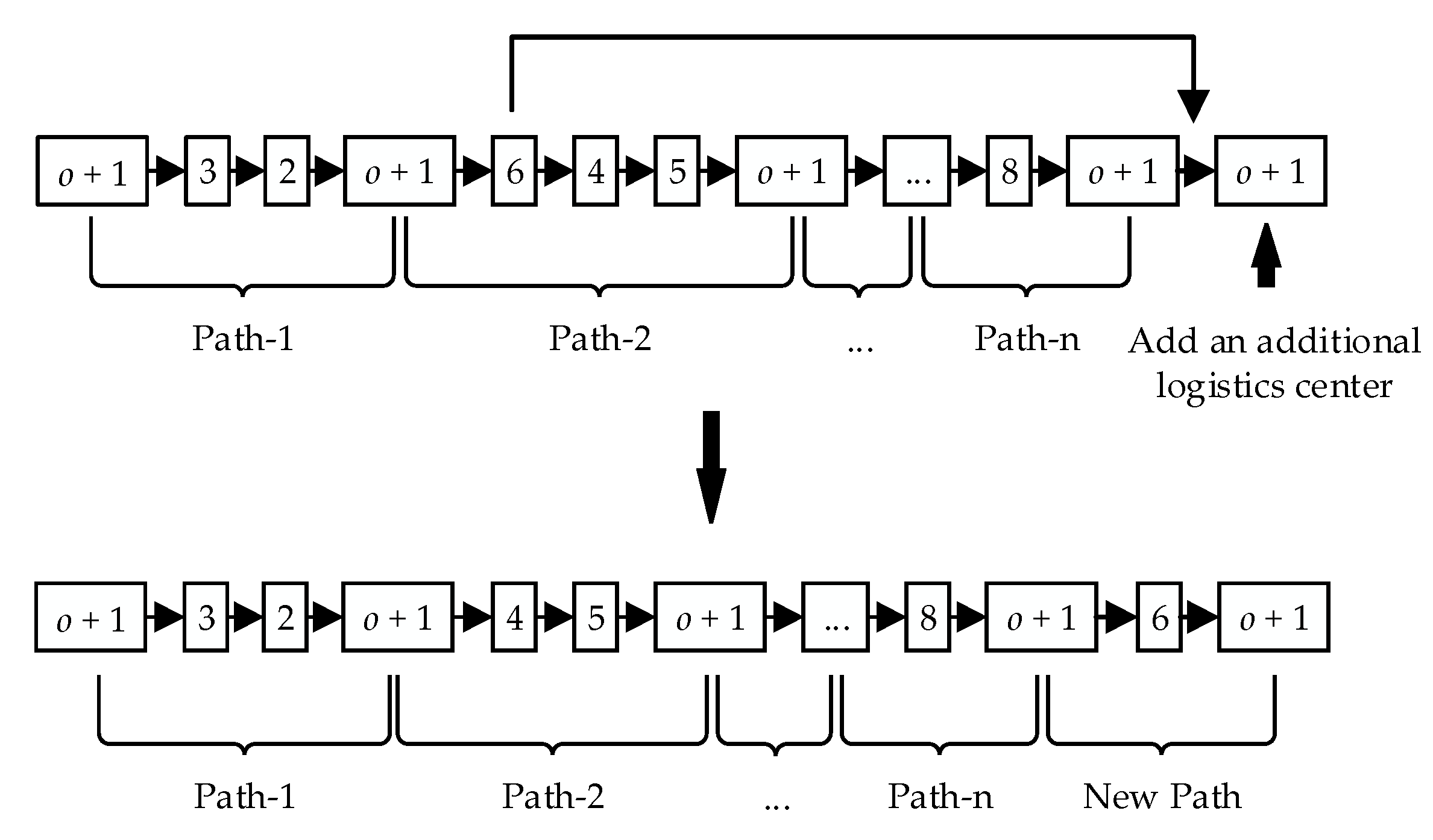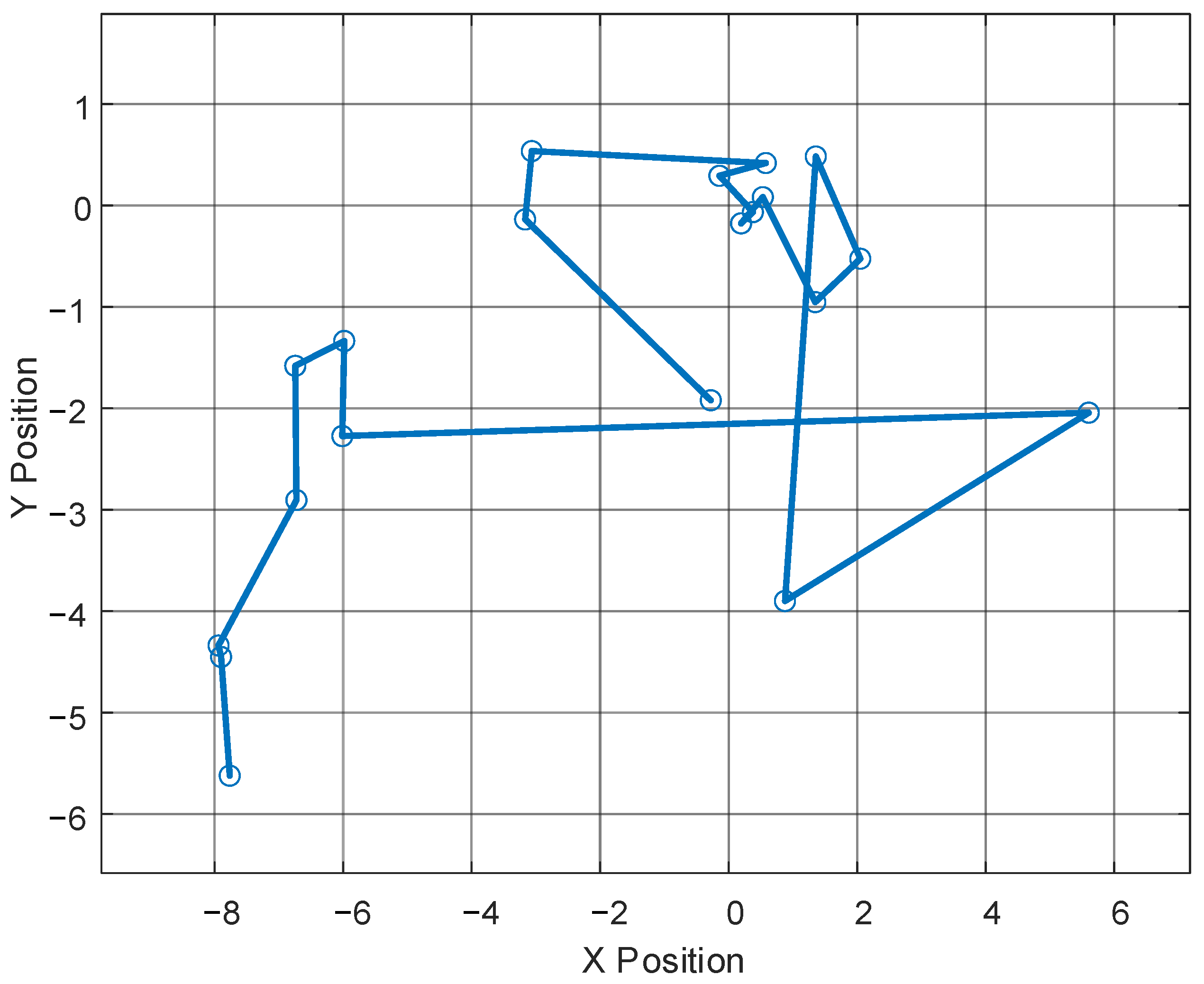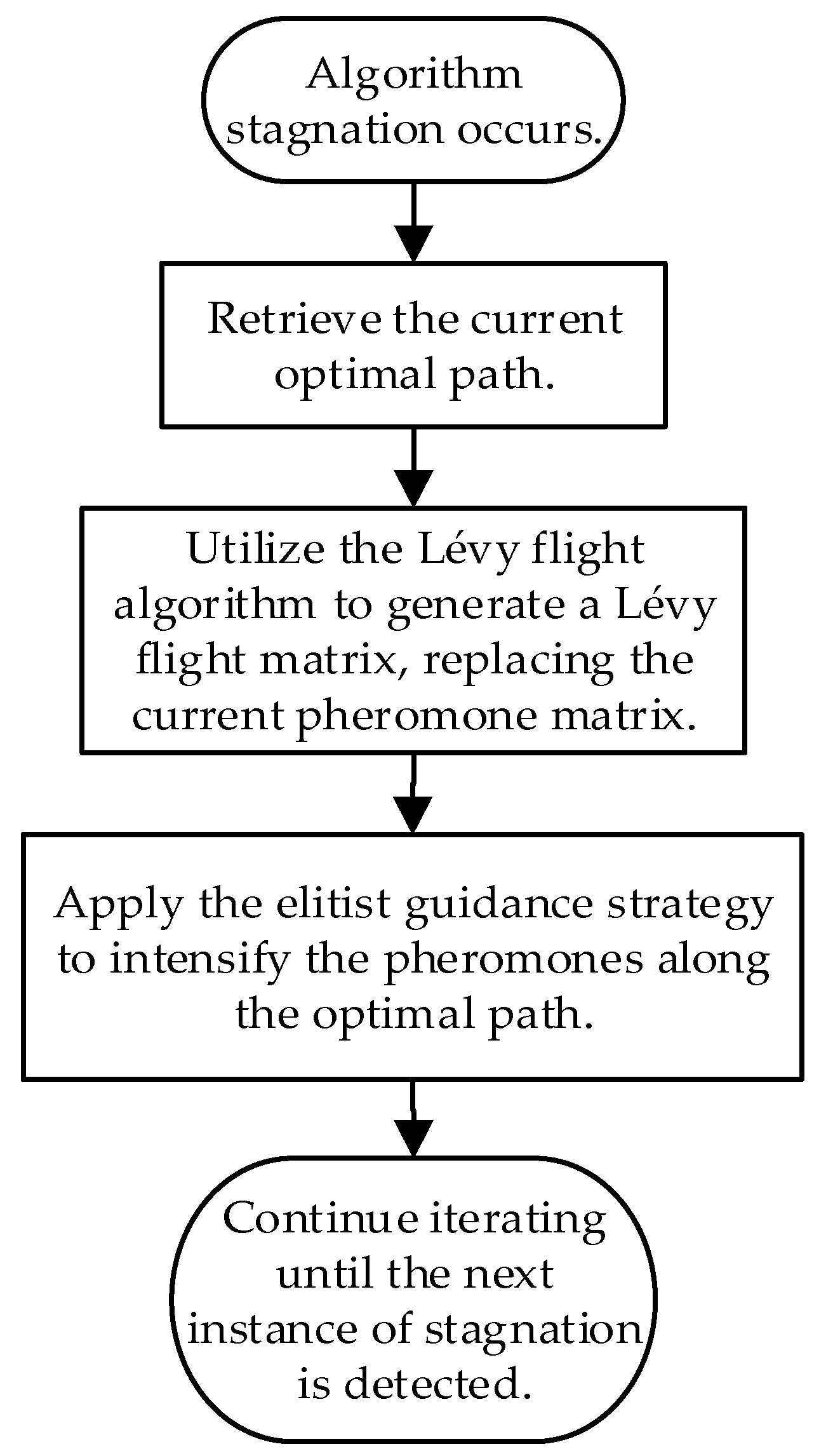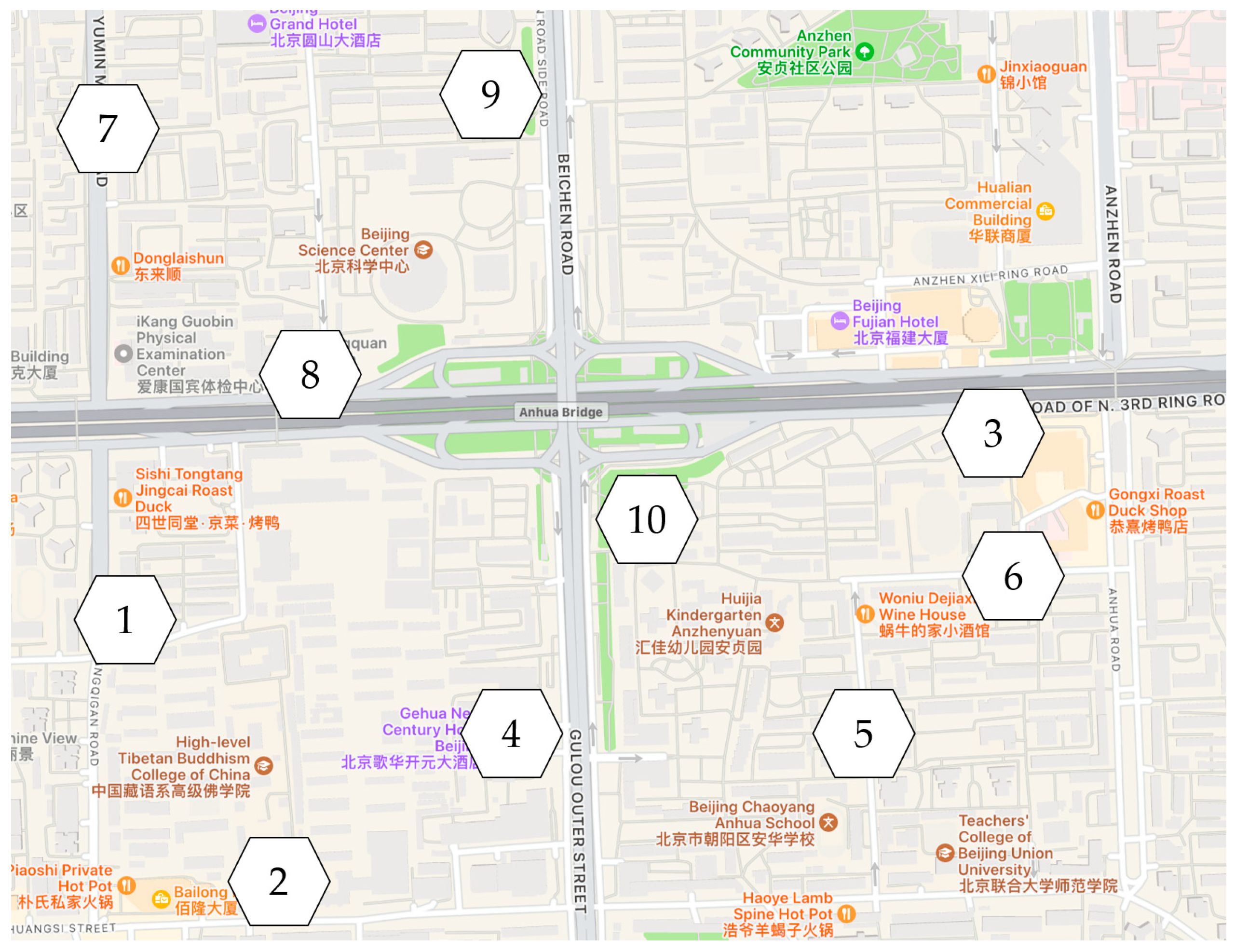Vehicle Route Planning of Diverse Cargo Types in Urban Logistics Based on Enhanced Ant Colony Optimization
Abstract
1. Introduction
1.1. The Vehicle Routing Problem and Its Derivatives
1.2. Overview of Metaheuristic Algorithms
1.3. Applications of ACO
1.4. Lévy Flight
2. Problem Description and Modeling
- Each vehicle departs from and returns to a single logistics center, with an ample supply of each type of vehicle available;
- Each distribution site is serviced once by the corresponding type of delivery vehicle;
- Each type of vehicle is only capable of transporting specific types of cargo in order to enhance the quality of transportation and ensure customer satisfaction;
- Vehicle movement between sites is unidirectional, and vehicles cannot backtrack;
- Vehicles are not permitted to alter their route mid-journey and must follow the predetermined path;
- Vehicles are considered to be unloaded when they leave the logistics center for the first distribution site, and the load must not exceed the maximum capacity defined for that vehicle type during transportation.
3. Enhanced Ant Colony Algorithm Design
3.1. Information Gathering
- The distance matrix between various sites and the logistics center;
- The quantities of various types of goods at each site, measured in tons;
- The types of goods that can be transported by each vehicle type, along with their maximum load capacities;
- The activation and distance costs for each vehicle model.
3.2. Create Paths
3.3. Cost Optimization
- In the existing route Path, add a new logistics center site o+1 at the end of the path. Taking site 6 as the transfer site, execute the relocation of cargo sites, and recalculate costs accordingly, as shown in Figure 1.
- Perform a relocation operation for each site i. It is possible to recalculate the new load Ci-new and the cost changes associated with the transportation route Ci-path.
- If capi-new < capw, select the minimum value among Ci-path values, denoted as Ci-path-min. If Cpath − Ci-path-min > 0, it indicates that relocating site i has reduced the path costs. Return to step 2 to continue new relocation operations, eventually generating Pathnew, and proceed to step 4. Otherwise, continue with Pathnew = Path, and move to step 5.
- Utilize Pathnew, the pathway modified following site translocations, as the prevailing route. Employ Equation (15) to calculate the revised aggregate costs, Cnew. And if the calculation results in C − Cnew < 0, this indicates that the strategic addition and relocation of sites within the new configuration have effectively reduced the total costs. Subsequently, redefine Path as Pathnew, and revert to step 1 for additional site relocation activities. Conversely, if C − Cnew > 0, indicating that the integration of additional vehicles has not yielded a cost reduction, persist with the initial route configuration, setting Pathnew = Path.
- Output the optimized path with reduced costs.
3.4. Pheromone Update
3.5. Lévy Flights and Elitist Guiding
4. Simulation
4.1. Simulation Construction
4.2. Simulation Results
- The payload capacity of refrigerated trucks was increased to 7 tons, and their unit transportation costs were raised to USD 6 per unit distance.
- The daily startup costs of fragile cargo trucks were reduced to USD 3 per day, and their unit transportation costs were raised to USD 5 per unit distance.
- The payload capacity of standard cargo trucks was raised to 6 tons. The unit transportation costs for standard cargo trucks were raised to USD 10 per unit distance, and the daily startup costs were reduced to USD 8 per day.
4.3. Data Analysis
5. Conclusions
Author Contributions
Funding
Data Availability Statement
Conflicts of Interest
References
- Sarbijan, M.S.; Behnamian, J. Emerging Research Fields in Vehicle Routing Problem: A Short Review. Arch. Comput. Method Eng. 2023, 30, 2473–2491. [Google Scholar] [CrossRef]
- Elshaer, R.; Awad, H. A Taxonomic Review of Metaheuristic Algorithms for Solving the Vehicle Routing Problem and Its Variants. Comput. Ind. Eng. 2020, 140, 106242. [Google Scholar] [CrossRef]
- Ni, Q.; Tang, Y. A Bibliometric Visualized Analysis and Classification of Vehicle Routing Problem Research. Sustainability 2023, 15, 7394. [Google Scholar] [CrossRef]
- Sarbijan, M.S.; Behnamian, J. Multi-Fleet Feeder Vehicle Routing Problem Using Hybrid Metaheuristic. Comput. Oper. Res. 2022, 141, 105696. [Google Scholar] [CrossRef]
- Alssager, M.; Othman, Z.A.; Ayob, M.; Mohemad, R.; Yuliansyah, H. Hybrid Cuckoo Search for the Capacitated Vehicle Routing Problem. Symmetry 2020, 12, 2088. [Google Scholar] [CrossRef]
- Holló-Szabó, Á.; Botzheim, J. Bacterial Memetic Algorithm for Asymmetric Capacitated Vehicle-Routing Problem. Electronics 2022, 11, 3758. [Google Scholar] [CrossRef]
- Yang, F.; Tao, F. A Bi-Objective Optimization VRP Model for Cold Chain Logistics: Enhancing Cost Efficiency and Customer Satisfaction. IEEE Access 2023, 11, 127043–127056. [Google Scholar] [CrossRef]
- Gu, Z.; Zhu, Y.; Wang, Y.; Du, X.; Guizani, M.; Tian, Z. Applying Artificial Bee Colony Algorithm to the Multidepot Vehicle Routing Problem. Softw.-Pract. Exp. 2022, 52, 756–771. [Google Scholar] [CrossRef]
- Ahmed, Z.H.; Hameed, A.S.; Mutar, M.L. Hybrid Genetic Algorithms for the Asymmetric Distance-Constrained Vehicle Routing Problem. Math. Probl. Eng. 2022, 2022, 2435002. [Google Scholar] [CrossRef]
- Li, C.; Zhu, Y.; Lee, K.Y. Route Optimization of Electric Vehicles Based on Reinsertion Genetic Algorithm. IEEE Trans. Transp. Electrif. 2023, 9, 3753–3768. [Google Scholar] [CrossRef]
- Liu, D.; Deng, Z.; Mao, X.; Yang, Y.; Kaisar, E.I. Two-Echelon Vehicle-Routing Problem: Optimization of Autonomous Delivery Vehicle-Assisted E-Grocery Distribution. IEEE Access 2020, 8, 108705–108719. [Google Scholar] [CrossRef]
- Ji, X.-F.; Pan, J.-S.; Chu, S.-C.; Hu, P.; Chai, Q.-W.; Zhang, P. Adaptive Cat Swarm Optimization Algorithm and Its Applications in Vehicle Routing Problems. Math. Probl. Eng. 2020, 2020, 1291526. [Google Scholar] [CrossRef]
- Zacharia, P.; Drosos, C.; Piromalis, D.; Papoutsidakis, M. The Vehicle Routing Problem with Fuzzy Payloads Considering Fuel Consumption. Appl. Artif. Intell. 2021, 35, 1755–1776. [Google Scholar] [CrossRef]
- Leng, K.; Li, S. Distribution Path Optimization for Intelligent Logistics Vehicles of Urban Rail Transportation Using VRP Optimization Model. IEEE Trans. Intell. Transp. Syst. 2022, 23, 1661–1669. [Google Scholar] [CrossRef]
- Dorigo, M.; Blum, C. Ant Colony Optimization Theory: A Survey. Theor. Comput. Sci. 2005, 344, 243–278. [Google Scholar] [CrossRef]
- Almufti, S.; Maribojoc, R.; Pahuriray, A. Ant Based System: Overview, Modifications and Applications from 1992 to 2022. Polaris Glob. J. Sch. Res. Trends 2022, 1, 29–37. [Google Scholar] [CrossRef]
- Liu, M.; Song, Q.; Zhao, Q.; Li, L.; Yang, Z.; Zhang, Y. A Hybrid BSO-ACO for Dynamic Vehicle Routing Problem on Real-World Road Networks. IEEE Access 2022, 10, 118302–118312. [Google Scholar] [CrossRef]
- Yin, C.; Fang, Q.; Li, H.; Peng, Y.; Xu, X.; Tang, D. An Optimized Resource Scheduling Algorithm Based on GA and ACO Algorithm in Fog Computing. J. Supercomput. 2024, 80, 4248–4285. [Google Scholar] [CrossRef]
- Duraiswamy, A.; Selvam, G. An Ant Colony-Based Optimization Model for Resource-Leveling Problem. In Proceedings of the Advances in Construction Management, Acmm 2021; Loon, L.Y., Subramaniyan, M., Gunasekaran, K., Eds.; Springer-Verlag Singapore Pte Ltd.: Singapore, 2022; Volume 191, pp. 333–342. [Google Scholar]
- Maheshwari, P.; Sharma, A.K.; Verma, K. Energy Efficient Cluster Based Routing Protocol for WSN Using Butterfly Optimization Algorithm and Ant Colony Optimization. Ad Hoc Netw. 2021, 110, 102317. [Google Scholar] [CrossRef]
- Lesch, V.; König, M.; Kounev, S.; Stein, A.; Krupitzer, C. Tackling the Rich Vehicle Routing Problem with Nature-Inspired Algorithms. Appl. Intell. 2022, 52, 9476–9500. [Google Scholar] [CrossRef]
- Huang, S.-H.; Huang, Y.-H.; Blazquez, C.A.; Chen, C.-Y. Solving the Vehicle Routing Problem with Drone for Delivery Services Using an Ant Colony Optimization Algorithm. Adv. Eng. Inform. 2022, 51, 101536. [Google Scholar] [CrossRef]
- Frias, N.; Johnson, F.; Valle, C. Hybrid Algorithms for Energy Minimizing Vehicle Routing Problem: Integrating Clusterization and Ant Colony Optimization. IEEE Access 2023, 11, 125800–125821. [Google Scholar] [CrossRef]
- Dorigo, M.; Stützle, T. Ant Colony Optimization: Overview and Recent Advances. In Handbook of Metaheuristics; Gendreau, M., Potvin, J.-Y., Eds.; Springer International Publishing: Cham, Switzerland, 2019; pp. 311–351. ISBN 978-3-319-91086-4. [Google Scholar]
- Li, J.; An, Q.; Lei, H.; Deng, Q.; Wang, G.-G. Survey of Levy Flight-Based Metaheuristics for Optimization. Mathematics 2022, 10, 2785. [Google Scholar] [CrossRef]
- Shen, Y.; Peng, L.; Li, J. An Improved Estimation of Distribution Algorithm for Multi-Compartment Electric Vehicle Routing Problem. J. Syst. Eng. Electron. 2021, 32, 365–379. [Google Scholar] [CrossRef]
- Odili, J.B.; Noraziah, A.; Zarina, M. A Comparative Performance Analysis of Computational Intelligence Techniques to Solve the Asymmetric Travelling Salesman Problem. Comput. Intell. Neurosci. 2021, 2021, 6625438. [Google Scholar] [CrossRef]




| Symbols | Definitions |
|---|---|
| O = {1, 2, 3, …, o, o+1} | The set of site includes o distribution sites, with the logistics center designated as site o+1. |
| V = {1, 2, 3, …, j} | The set of vehicle numbers consists of j vehicles. |
| T = {1, 2, 3, …, h} | The set of cargo types includes h different types of goods. |
| W = {1, 2, 3, …, n} | The set of vehicle types comprises n models. |
| capw | The maximum load capacity of vehicle type w. |
| cw | The unit transportation cost per distance for vehicle type w. |
| sw dt | The startup cost for vehicle type w. The maximum allowable transport distance of cargo type t. |
| qil | The quantity of cargo type l at distribution site i. |
| a, b ∈ O | Transportation route nodes a and b. |
| dab eab | The distance between nodes a and b. The traffic congestion coefficient between nodes a and b, eab ≥ 1. |
| gvw ∈ {0,1} | If vehicle v belongs to vehicle type w, then gvw = 1, otherwise 0. |
| hwt ∈ {0,1} | If vehicle type w transports cargo type t, then hwt = 1, otherwise 0. |
| mwt ∈ {0,1} | If vehicle type w can transport cargo type t, then mwt = 1, otherwise 0. |
| xv ∈ {0,1} | If vehicle v is activated, then xv = 1, otherwise 0. |
| yabv ∈ {0,1} | If vehicle v transports from node a to node b, then yabv = 1, otherwise 0. |
| C | The total cost, including startup and transportation costs. |
| Number | 1 | 2 | 3 | 4 | 5 | 6 | 7 | 8 | 9 | 10 |
|---|---|---|---|---|---|---|---|---|---|---|
| 1 | - | 0.5 | 1.3 | 1.2 | 1.5 | 1.9 | 2.4 | 3.3 | 2.7 | 2.2 |
| 2 | 0.5 | - | 1.4 | 0.6 | 0.9 | 1.2 | 2.3 | 3.1 | 2.5 | 1.0 |
| 3 | 2.2 | 1.7 | - | 1.8 | 1.2 | 0.4 | 3.2 | 4.0 | 3.4 | 0.9 |
| 4 | 1.1 | 0.6 | 1.5 | - | 1.0 | 1.7 | 2.4 | 3.2 | 2.7 | 1.1 |
| 5 | 1.3 | 0.9 | 0.7 | 0.9 | - | 0.5 | 2.3 | 3.1 | 2.6 | 0.5 |
| 6 | 1.7 | 1.2 | 0.2 | 1.6 | 1.0 | - | 2.3 | 3.1 | 2.6 | 0.4 |
| 7 | 2.7 | 2.2 | 2.1 | 1.6 | 2.3 | 2.3 | - | 0.8 | 0.8 | 2.6 |
| 8 | 2.8 | 2.8 | 2.7 | 2.2 | 2.9 | 2.9 | 0.6 | - | 1.4 | 2.9 |
| 9 | 1.8 | 1.3 | 1.2 | 0.8 | 1.5 | 1.5 | 1.1 | 0.5 | - | 1.5 |
| 10 | 3.0 | 2.0 | 0.7 | 2.1 | 1.4 | 0.4 | 1.9 | 1.6 | 2.3 | - |
| Number | Perishable Cargo | Fragile Cargo | Standard Cargo |
|---|---|---|---|
| 1 | 2.13 | 0.49 | 2.68 |
| 2 | 2.31 | 0.16 | 1.78 |
| 3 | 0.75 | 0.49 | 1.59 |
| 4 | 2.33 | 0.48 | 1.22 |
| 5 | 1.76 | 0.29 | 2.71 |
| 6 | 0.70 | 0.42 | 1.76 |
| 7 | 1.06 | 0.16 | 1.61 |
| 8 | 1.59 | 0.27 | 2.65 |
| 9 | 2.42 | 0.47 | 1.65 |
| Symbol | Definition | Value | ||
|---|---|---|---|---|
| AGA | ACO | Lévy-EGACO | ||
| - | α | α | Pheromone factor | [0.5,2], step 0.1 |
| - | β | β | Heuristic information factor | [1,3], step 0.1 |
| - | ρ | ρ | Evaporation coefficient | [0.1,0.5], step 0.1 |
| - | - | N0 | Elitist guidance intensification multiplier | 2 |
| - | - | θ | Random restart threshold | 20 |
| pc | - | - | Crossover rate | 0.9 |
| pm | - | - | Mutation rate | 0.1 |
| γc | - | - | Adaptation factor for crossover rate | 0.1 |
| γm | - | - | Adaptation factor for mutation rate | 0.1 |
| Niter | Niter | Niter | Number of iterations | 500 |
| N | N | N | Number of population size/ants | 100/20 |
| Cost | Lévy-EGACO | ACO | AGA | ||||||
|---|---|---|---|---|---|---|---|---|---|
| Best | Average | Optimal Ratio | Best | Average | Optimal Ratio | Best | Average | Optimal Ratio | |
| Refrigerated | 100.8 | 100.88 | 95% | 102 | 103.14 | 45% | 102 | 103.12 | 55% |
| Fragile | 49.25 | 49.25 | 100% | 49.25 | 49.25 | 100% | 49.25 | 49.25 | 100% |
| Standard | 186 | 186 | 100% | 186 | 189.85 | 15% | 186 | 190.05 | 10% |
| Total | 336.05 | 336.13 | - | 337.25 | 342.24 | - | 337.25 | 342.42 | - |
| Number | Vehicle Type | Transportation Route | Load/Ton |
|---|---|---|---|
| 1 | Refrigerated cargo trucks | 10-6-1-5-10 | 4.59 |
| 2 | Refrigerated cargo trucks | 10-8-7-4-10 | 4.95 |
| 3 | Refrigerated cargo trucks | 10-9-2-10 | 4.73 |
| 4 | Refrigerated cargo trucks | 10-3-10 | 0.75 |
| 5 | Fragile cargo trucks | 10-6-3-5-1-2-10 | 1.85 |
| 6 | Fragile cargo trucks | 10-8-7-9-4-10 | 1.38 |
| 7 | Standard cargo trucks | 10-6-5-10 | 4.47 |
| 8 | Standard cargo trucks | 10-1-2-10 | 4.46 |
| 9 | Standard cargo trucks | 10-7-9-4-10 | 4.48 |
| 10 | Standard cargo trucks | 10-8-3-10 | 4.42 |
| Cost | Lévy-EGACO | ACO | AGA | ||||||
|---|---|---|---|---|---|---|---|---|---|
| Best | Average | Optimal Ratio | Best | Average | Optimal Ratio | Best | Average | Optimal Ratio | |
| Refrigerated | 97.2 | 97.2 | 100% | 99.6 | 101.67 | 10% | 99.6 | 101.61 | 10% |
| Fragile | 53.5 | 53.5 | 100% | 53.5 | 53.5 | 100% | 53.5 | 53.5 | 100% |
| Standard | 106.4 | 106.46 | 95% | 107.6 | 108.32 | 45% | 107.6 | 107.99 | 50% |
| Total | 257.1 | 257.16 | - | 260.7 | 263.49 | - | 260.7 | 263.1 | - |
| Number | Vehicle Type | Transportation Route | Load/Ton |
|---|---|---|---|
| 1 | Refrigerated cargo trucks | 10-8-7-9-5-10 | 6.83 |
| 2 | Refrigerated cargo trucks | 10-4-1-2-10 | 6.77 |
| 3 | Refrigerated cargo trucks | 10-3-6-10 | 1.45 |
| 4 | Fragile cargo trucks | 10-6-3-5-1-2-10 | 1.85 |
| 5 | Fragile cargo trucks | 10-8-7-9-4-10 | 1.38 |
| 6 | Standard cargo trucks | 10-4-1-2-10 | 5.68 |
| 7 | Standard cargo trucks | 10-8-7-9-10 | 5.91 |
| 8 | Standard cargo trucks | 10-3-5-10 | 4.3 |
| 9 | Standard cargo trucks | 10-6-10 | 1.76 |
Disclaimer/Publisher’s Note: The statements, opinions and data contained in all publications are solely those of the individual author(s) and contributor(s) and not of MDPI and/or the editor(s). MDPI and/or the editor(s) disclaim responsibility for any injury to people or property resulting from any ideas, methods, instructions or products referred to in the content. |
© 2024 by the authors. Published by MDPI on behalf of the World Electric Vehicle Association. Licensee MDPI, Basel, Switzerland. This article is an open access article distributed under the terms and conditions of the Creative Commons Attribution (CC BY) license (https://creativecommons.org/licenses/by/4.0/).
Share and Cite
Tan, L.; Zhu, K.; Yi, J. Vehicle Route Planning of Diverse Cargo Types in Urban Logistics Based on Enhanced Ant Colony Optimization. World Electr. Veh. J. 2024, 15, 405. https://doi.org/10.3390/wevj15090405
Tan L, Zhu K, Yi J. Vehicle Route Planning of Diverse Cargo Types in Urban Logistics Based on Enhanced Ant Colony Optimization. World Electric Vehicle Journal. 2024; 15(9):405. https://doi.org/10.3390/wevj15090405
Chicago/Turabian StyleTan, Lingling, Kequan Zhu, and Junkai Yi. 2024. "Vehicle Route Planning of Diverse Cargo Types in Urban Logistics Based on Enhanced Ant Colony Optimization" World Electric Vehicle Journal 15, no. 9: 405. https://doi.org/10.3390/wevj15090405
APA StyleTan, L., Zhu, K., & Yi, J. (2024). Vehicle Route Planning of Diverse Cargo Types in Urban Logistics Based on Enhanced Ant Colony Optimization. World Electric Vehicle Journal, 15(9), 405. https://doi.org/10.3390/wevj15090405







